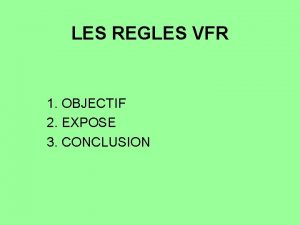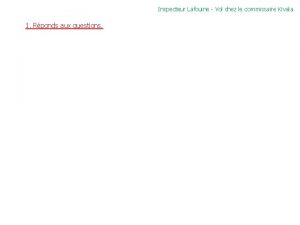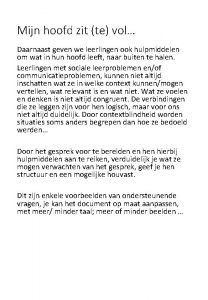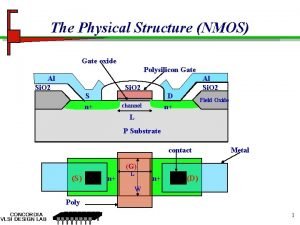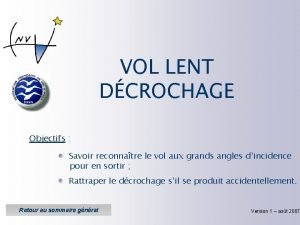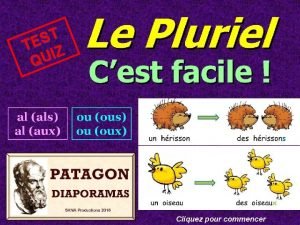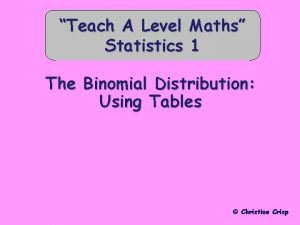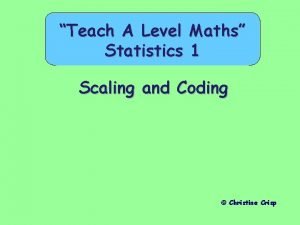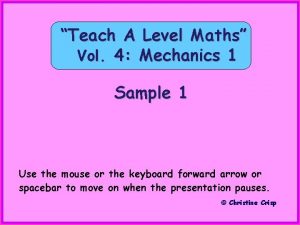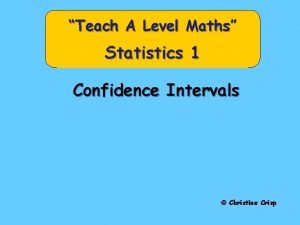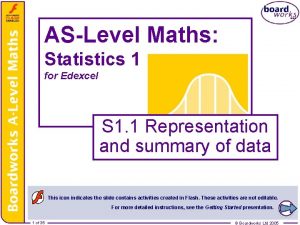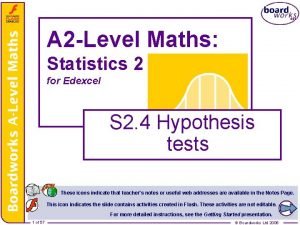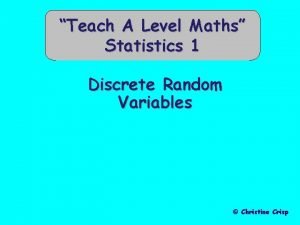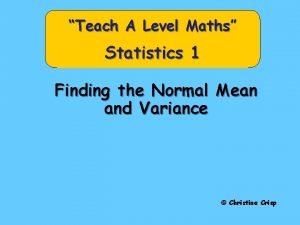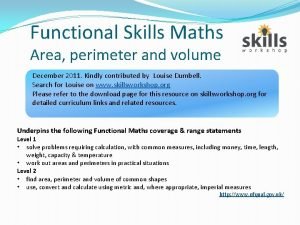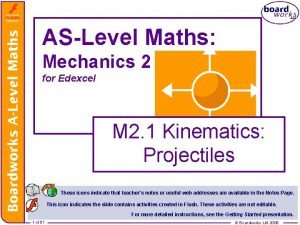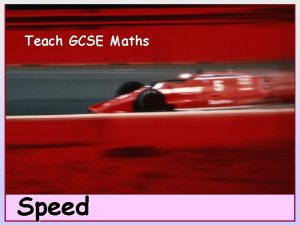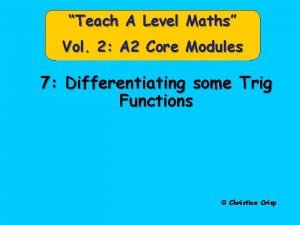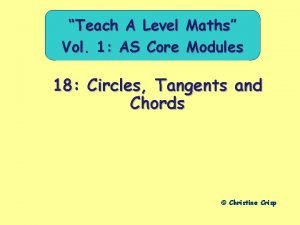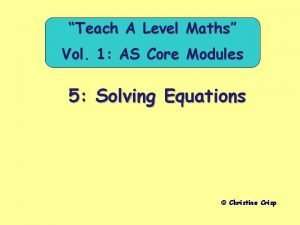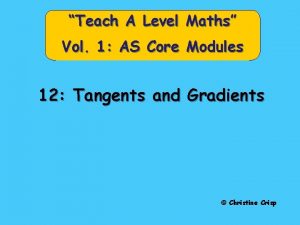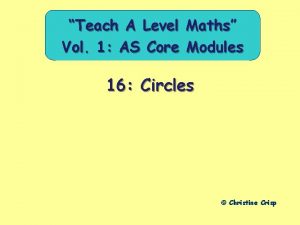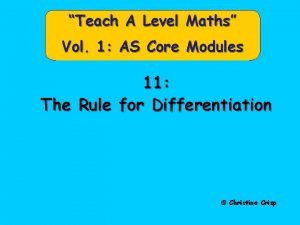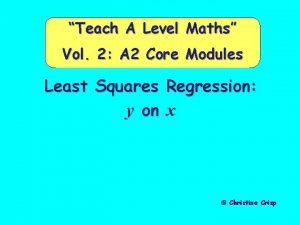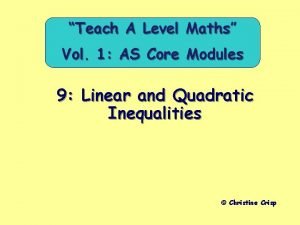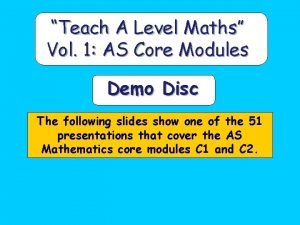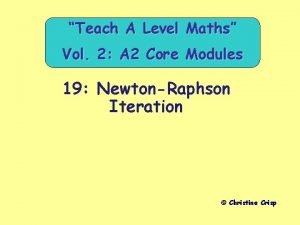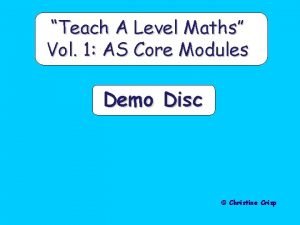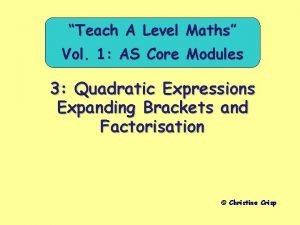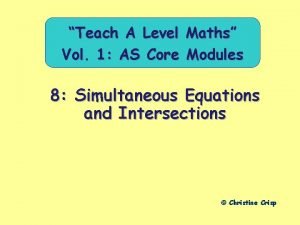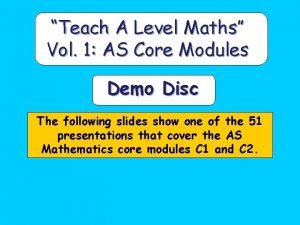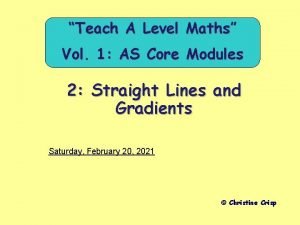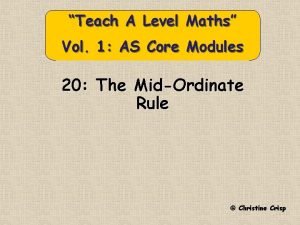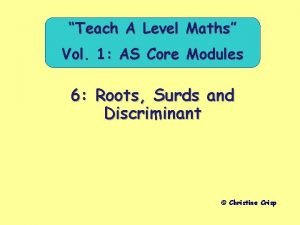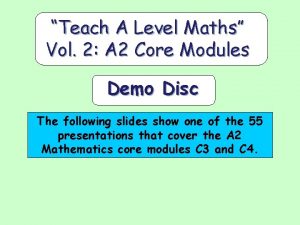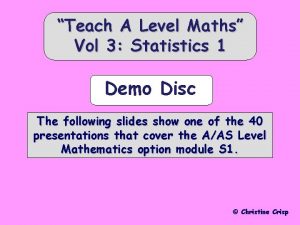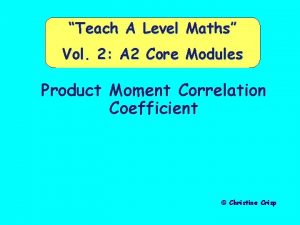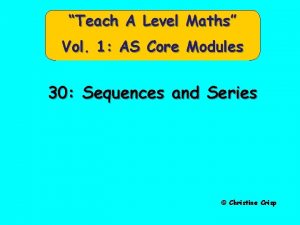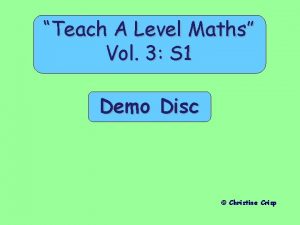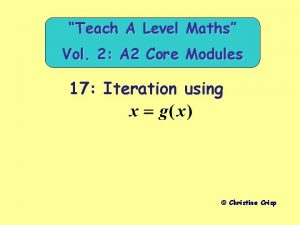Teach A Level Maths Vol 4 Mechanics 1








































- Slides: 40

“Teach A Level Maths” Vol. 4: Mechanics 1 Sample 1 Use the mouse or the keyboard forward arrow or spacebar to move on when the presentation pauses. © Christine Crisp

Whilst these presentations are relevant to any introductory course in Mechanics, particular attention has been paid to the material in the M 1 specifications offered at GCE A/AS level by the three English Awarding Bodies: AQA, Edexcel and OCR has two specifications so, to distinguish between them, the 2 nd is referred to as MEI. Where a topic relates to some specifications only, this is indicated in a contents file and also at the start of the presentation.

The slides that follow are samples from 7 of the 29 presentations.

5: Vectors for Mechanics This presentation about vectors has been structured so that teachers can cover, or revise, the vector theory that is required in mechanics. The other presentations that use vectors are hyperlinked to this one to make it easy to dip in and out. The next 4 slides come from the section on the unit vectors i and j.

Instead of drawing diagrams to show vectors we can use unit vectors. A unit vector has magnitude 1. The unit vectors i and j are parallel to the x- and y-axes respectively. e. g. A velocityv is given by v = (3 i + 4 j ) m s -1 y v 4 j i 3 x In text-books single letters for vectors are printed in bold but we must underline them.

The magnitude of velocity is speed, so, using Pythagoras’ theorem, v = 32 + 42 v=5 So, We if we canhave writethe v orunit v vector form, we use the for speed. numbers in front of i and j No i or j in magnitude j y i v 4 3 x v = 3 i + 4 j v = 32 + 42 Tip: Squares of real numbers are always positive so we never need any minus signs.

v = 3 i + 4 j The direction of the vector is found by using trig. j y i v 4 tan q = 53· 1 ( 3 s. f. ) 3 BUT beware ! x

For v = 3 i + 4 j we have q = 53· 1 ( 3 s. f. ) Suppose v = -3 i - 4 j Without a diagram we get tan q = -4 -3 So again q = 53· 1 ( 3 s. f. ) But, the vectors are not the same ! If we need the direction of a 3 vector when unit vectors are used, we must sketch qthe vector to j v = 3 i + 4 show the angle we have found. 4 q 3 4 v = -3 i - 4 j

6: Equations of Motion for Constant Acceleration In this extract the students are shown how to use a velocity-time graph to develop the equations of motion for constant acceleration. To give the students confidence, they are sometimes asked to share ideas with a partner.

We can use a velocity-time graph to find some equations that hold for a body moving in a straight line with constant acceleration. Suppose when the time is 0. . velocity (ms -1) the velocity is u. . v Constant acceleration means the graph is a straight line. u 0 t time (s) At any time, t, we let the velocity be v. Remind your partner how to find acceleration from a velocity-time graph. Ans: The gradient gives the acceleration.

We can use a velocity-time graph to find some equations that hold for a body moving in a straight line with constant acceleration. Suppose when the time is 0. . velocity (ms -1) the velocity is u. . v Constant acceleration means v-u the graph is a straight line. u 0 t t time (s) So, At any time, t, we let the velocity be v. a= v-u t From this equation we can find the value of any of the 4 quantities if we know the other 3.

a= v-u t We usually learn the formula withv as the “subject”. Multiplying by t: at = v - u u + at = v v = u + at The velocity, u, at the start of the time is often called the initial velocity.

9: Displacement and Velocity using Unit Vectors Throughout the course students are encouraged to draw diagrams to help them solve problems.

e. g. 2 A ship is at a point. A given by the position vector r A = (-4 i + 3 j ) km The ship has a constant velocity of 6 km i h -1. After half-an-hour the ship is at a point B. Find (a) the displacement of B from A, and (b) the position vector of B. Solution: We can solve this problem without a diagram, but a diagram can help us to see the method.

Velocity v = 6 i km h -1 After half-an-hour the ship is at a point B. Solution: (a) Find the displacement of B from A. A: r A = (-4 i + 3 j ) km Constant velocity displacement = velocity time s = 6 i 0· 5 = 3 i km (b) Find the position vector of B. r. B = r. A + s r B = (-4 i + 3 j ) + 3 i = (- i + 3 j ) km Ax 6 i s Bx r. A 3 y r. B x 4 O

12: Momentum and Collisions Each presentation has a simple summary page that teachers can ask students to copy into their notes. A version of the summary is given, without colour, at the end of each presentation so that photocopies can be made if preferred.

SUMMARY Momentum = mass velocity Momentum is a vector. The units of momentum are kgm s -1. In a collision, the conservation of momentum gives: total momentum before = the total momentum after Ø Solving collision problems: • Draw before and after diagrams giving mass and velocity ( showing the direction with an arrow ). • Write the momentum statement (can abbreviate ). + to show the positive direction. • Draw Ø Ø • Write the equation remembering to add the momentums but watching for negative velocities.

17: The Resultant of Forces by Resolving In the presentation before this one students have practised resolving forces. Here they see how to collect components and then to find the resultant. At this stage some students may still be having difficulties finding components, so they are reminded of the process. The calculator symbol appears where students may benefit from doing the calculation themselves.

e. g. 1 The forces shown in the diagram are in newtons. Find the magnitude and direction of the resultant. y 10 6 60 4 x The 6 and 10 newton forces lie along the axes so we only need to resolve the 4 newton force. You may be able to see directly what the components are but don’t take chances. If you need a triangle to help you, draw it to one side.

e. g. 1 The forces shown in the diagram are in newtons. Find the magnitude and direction of the resultant. y 10 6 60 x 4 4 We can always find 1 angle in the triangle from the original diagram.

e. g. 1 The forces shown in the diagram are in newtons. Find the magnitude and direction of the resultant. y 10 4 cos 60 60 x 4 4 sin 60 4 Tell your partner what the expression is for each 10 component. Ans: Across the 60 gives 4 cos 60. . . the other component is 4 sin 60

e. g. 1 The forces shown in the diagram are in newtons. Find the magnitude and direction of the resultant. y 10 4 cos 60 60 x 4 4 sin 60 4 Now we collect all the components in thex and y directions. X = - 10 + 4 cos 60 and then check I must the arrow the on remember each force arrow Y = + 6 - 4 sin 60 X = -8 Y = 2· 5358… Store this in a memory on Y =your 2· 54 calculator. ( 3 s. f. )

e. g. 1 The forces shown in the diagram are in newtons. Find the magnitude and direction of the resultant. y 10 6 X = -8 60 x 4 Now we have just 2 components, we can find the resultant. Y = 2· 54

e. g. 1 The forces shown in the diagram are in newtons. Find the magnitude and direction of the resultant. y 10 6 X = -8 60 x Y = 2· 54 4 Now we have just 2 components, we can find the resultant. Reversing the arrow takes care of the minus sign. 8

e. g. 1 The forces shown in the diagram are in newtons. Find the magnitude and direction of the resultant. y 10 6 X = -8 60 x Y = 2· 54 4 Now we have just 2 components, we can find the resultant. 2· 54 8

e. g. 1 The forces shown in the diagram are in newtons. Find the magnitude and direction of the resultant. y 6 X = -8 60 10 x Y = 2· 54 4 Now we have just 2 components, we can find the resultant. 2· 54 F = + q 8 F = 8· 39 newtons ( 3 s. f. ) s. f. but weuse the 2· 54 can write tanq = We q =317· 6 ( 3 s. f. ) 8 number stored on the calculator. F 2 82 2· 542 ( as shown in the sketch )

21: Newton’s 2 nd Law This is the first of a variety of examples used to illustrate Newton’s 2 nd Law.

e. g. 1 A pebble of mass 0· 2 kg is dropped from the top of a cliff. Find the acceleration of the pebble as it falls, assuming that the pebble falls in a straight line and there is a constant resistance of 0· 06 newtons. Solution: Tip: When we are given mass rather than weight, it’s a good idea to use W = mg to replace W on the diagram. particle 0· 2 g W

e. g. 1 A pebble of mass 0· 2 kg is dropped from the top of a cliff. Find the acceleration of the pebble as it falls, assuming that the pebble falls in a straight line and there is a constant resistance of 0· 06 newtons. Solution: 0· 06 We don’t substitute for g at this stage since we need to see both mass and weight clearly in the diagram. a particle 0· 2 g

e. g. 1 A pebble of mass 0· 2 kg is dropped from the top of a cliff. Find the acceleration of the pebble as it falls, assuming that the pebble falls in a straight line and there is a constant resistance of 0· 06 newtons. Solution: N 2 L: Resultant force = mass acceleration 0· 06 a particle 0· 2 g Beware We always resolve in the! On the of left-hand side of the equation direction the acceleration. we have force, so we needweight. On the right-hand side we havemass.

e. g. 1 A pebble of mass 0· 2 kg is dropped from the top of a cliff. Find the acceleration of the pebble as it falls, assuming that the pebble falls in a straight line and there is a constant resistance of 0· 06 newtons. Solution: N 2 L: Resultant force = mass acceleration 0· 2 g - 0· 06 = 0· 2 a 0· 2 9· 8 - 0· 06 = 0· 2 a 1· 9 = a a = 9· 5 ms -2 0· 2 0· 06 a particle 0· 2 g

24: Connected Particles and Newton’s 3 rd Law The following example shows a pulley problem. It covers the methods used to find the forces and acceleration of the system, including the force on the pulley.

e. g. 2. A particle, A, of mass 0· 6 kg, is held at rest on a smooth table. A is connected by a light, inextensible string, which passes over a smooth fixed pulley at the edge of the table, to another particle, B, of mass 0· 4 kg hanging freely. The string is horizontal and at right angles to the edge of the table. A A is released. Find (a) the magnitude of the reaction of the table on A, B (b) the acceleration of the system (c) the tension in the string, and (d) the force on the pulley due to the particles.

A: mass 0· 6 kg B: mass 0· 4 kg R A 0· 6 g a T T B 0· 4 g a Solution: N 2 L: Resultant force = mass acceleration (a) Find R. A: R - 0· 6 g = 0 R = 0· 6 g - - (1) R = 5· 88 newtons ( 3 s. f. ) (b) Find a. A accelerates horizontally, so there is no A: T = 0· 6 a - - (2) vertical component of acceleration. 0· 4 g - T = 0· 4 a - - (3) B:

A: mass 0· 6 kg B: mass 0· 4 kg R A 0· 6 g a T T B 0· 4 g (b) Find a. a R = 5· 88 N T = 0· 6 a - - (2) 0· 4 g - T = 0· 4 a - - (3) (2) + (3): 0· 4 g = a a = 0· 4 9· 8 a = 3· 92 m s -2 (c) Find T. Substitute in (2): T = 0· 6 3· 92 T = 2· 35 newtons ( 3 s. f. )

A: mass 0· 6 kg B: mass 0· 4 kg a = 3· 92 m s -2 T = 2· 35 N R A 0· 6 g T a T T T B 0· 4 g a (d) Find the force on the pulley due to the particles. T Since the 2 forces are equal, the What can you say about the 45 resultant liesofbetween them, ? at an direction the resultant F T equal angle to each. F = T cos 45 + T cos 45 = 2 T cos 45 F = 3· 33 newtons ( 3 s. f. ) Reminder: Use the value of. T from your calculator so that your answer will be correct to 3 s. f.

The next 2 slides contain the names of all 29 presentations. Number 20, “Bodies in Equilibrium” is provided in full as Sample 2. The title is hyperlinked to the presentation.

Teach A Level Maths – Mechanics 1 1. Introducing Mechanics 11. Resultant Velocity (AQA) 2. Distance and Speed 12. Momentum and Collisions 3. Displacement and Velocity 13. 2 -D Collisions (AQA) 4. Acceleration and Graphs 14. Impulse in Collisions (Edexcel) 5. Vectors for Mechanics 15. The Resultant of 2 Forces 6. Constant Acceleration Equations Vertical Motion under Gravity 16. Components of a Force 7. 8. Bearings 9. Displacement and Velocity using Unit Vectors 10. Relative Velocity in 1 Dimension (MEI) 17. The Resultant of Forces by Resolving 18. Equilibrium 19. Force Diagrams and Newton’s 1 st Law 20. Bodies in Equilibrium 21. Newton’s 2 nd Law continued

Teach A Level Maths – Mechanics 1 22. Coefficient of Friction, 1 (AQA, Edexcel and OCR) 23. Coefficient of Friction, 2 (AQA, Edexcel and OCR) 24. Connected Particles and Newton’s 3 rd Law 25. Connected Particles, 2 26. Projectiles, 1 (AQA and MEI) 27. Projectiles, 2 (AQA and MEI) 28. Moment of a Force (Edexcel) 29. Motion Using Calculus (OCR and MEI)

Full version available from: Chartwell-Yorke Ltd. 114 High Street, Belmont Village, Bolton, Lancashire, BL 7 8 AL England tel (+44) (0)1204 811001, fax (+44) (0)1204 811008 info@chartwellyorke. com www. chartwellyorke. com
 Nzqa mechanics level 3
Nzqa mechanics level 3 Diagramme de classe réservation vol
Diagramme de classe réservation vol Conc moles volume
Conc moles volume Vprob
Vprob Dsr 2019 vol 1
Dsr 2019 vol 1 Vinjak sastav
Vinjak sastav Wat is die intensiewe vorm van nodig
Wat is die intensiewe vorm van nodig Horticulture dsr 2018
Horticulture dsr 2018 Kcal vaasje bier
Kcal vaasje bier Vca vol pbna
Vca vol pbna Vader vol van vrees
Vader vol van vrees Vol and voh
Vol and voh Vol plané
Vol plané Interruption volontaire du vol
Interruption volontaire du vol The vol command is used to
The vol command is used to Cse477
Cse477 Ap3456 vol 5
Ap3456 vol 5![[anthology] lq -little queen- vol. 40 [digital] [anthology] lq -little queen- vol. 40 [digital]](data:image/svg+xml,%3Csvg%20xmlns=%22http://www.w3.org/2000/svg%22%20viewBox=%220%200%20200%20200%22%3E%3C/svg%3E) [anthology] lq -little queen- vol. 40 [digital]
[anthology] lq -little queen- vol. 40 [digital] Exposé sur vol de nuit
Exposé sur vol de nuit Principe de bernoulli
Principe de bernoulli Vol chez le commissaire kivala
Vol chez le commissaire kivala Vol-vyoo-lus
Vol-vyoo-lus Gevoelensthermometer
Gevoelensthermometer N+ polysilicon
N+ polysilicon Vol lent
Vol lent éventaux
éventaux Swaption volatility surface
Swaption volatility surface Vca pbna
Vca pbna Comment peut on s'imaginer en voyant un vol d'hirondelles
Comment peut on s'imaginer en voyant un vol d'hirondelles Vol de nuit citation
Vol de nuit citation Binomial inequalities
Binomial inequalities Coding maths a level
Coding maths a level Pulleys a level maths
Pulleys a level maths What is z in confidence interval formula
What is z in confidence interval formula Gl progress test sample papers science
Gl progress test sample papers science Linear interpolation a level maths
Linear interpolation a level maths Edexcel a level maths hypothesis testing
Edexcel a level maths hypothesis testing Discrete random variable
Discrete random variable Variance formula a level maths
Variance formula a level maths Functional skills maths level 2 area and perimeter
Functional skills maths level 2 area and perimeter Projectiles a level maths
Projectiles a level maths
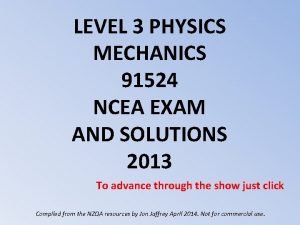
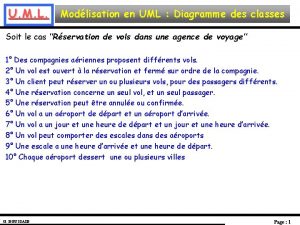



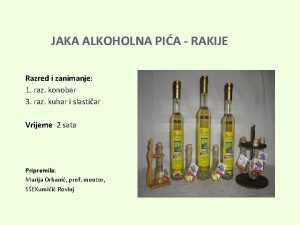
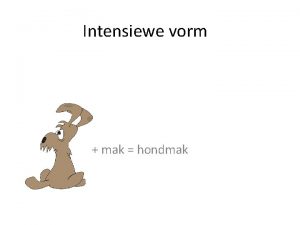

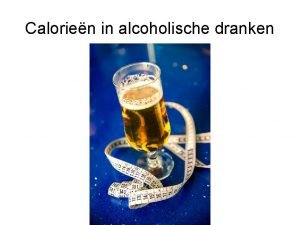

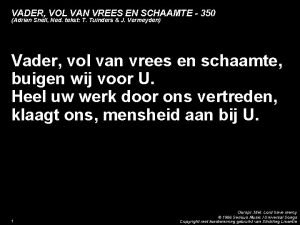
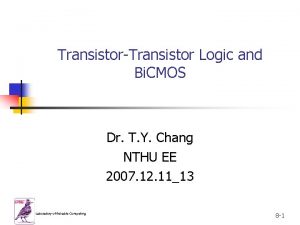
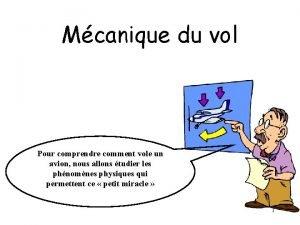

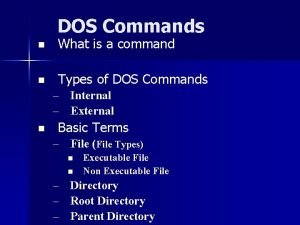
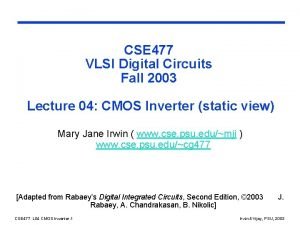
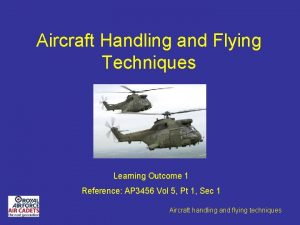
![[anthology] lq -little queen- vol. 40 [digital] [anthology] lq -little queen- vol. 40 [digital]](https://slidetodoc.com/wp-content/uploads/2020/12/3346623_ae8474c31416d58beb43272c3ea4efb2-300x225.jpg)
